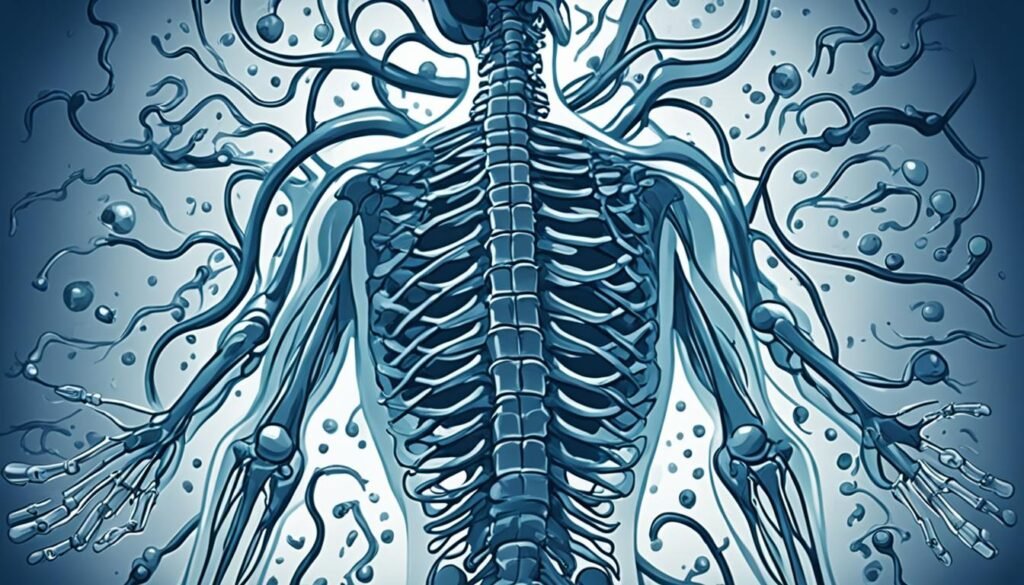Have you ever felt odd numbness in your arms, sudden weakness, or strange headaches with no clear cause? If yes, you might want to understand what is syringomyelia, a rare spinal cord issue that hides in plain sight for years.
This spinal condition often develops quietly but can leave a lasting impact on your ability to feel, move, or even control your bladder. Many patients brush off the early signs, thinking it’s just fatigue or stress. But what’s really happening inside the spine can be far more serious.
In this blog, we will explain what is syringomyelia, why it happens, how to spot it early, and what treatments actually help. We’ll also go over recovery stories, expert tips, and how you or your loved one can manage life with this condition.
Table of Contents
ToggleWhat is Syringomyelia?
What is syringomyelia? It’s a condition where a fluid-filled cyst (called a syrinx) forms inside your spinal cord. Over time, this syrinx gets bigger and starts damaging the spinal nerves.
The spinal cord is a soft, tube-like structure running down your back. It’s surrounded by cerebrospinal fluid (CSF), which acts like a cushion. In syringomyelia, this fluid builds up inside the spinal cord instead of flowing around it. This trapped fluid forms the syrinx.
One of the key reasons this happens is cerebrospinal fluid blockage, which changes how the fluid flows. The blockage might be caused by birth defects, injury, tumors, or even infections.
How common is syringomyelia? It affects about 1 in every 12,000 to 15,000 people globally. That’s rare, but not rare enough to ignore.
The syrinx typically forms in the cervical spine (neck area) or the upper thoracic spine (upper back), which are key regions of the spinal cord.
Types of Syringomyelia
There are two main forms: one that’s present from birth and the other you can develop. Congenital syringomyelia happens when part of the brain goes into the spinal canal. It slows down the fluid moving through the spinal cord. This mostly affects the neck area.
Acquired syringomyelia can happen because of different reasons. These include spinal cord injury, meningitis, and spinal cord tumors. It’s caused by things you might face after birth.

What Are the First Warning Signs of Syringomyelia?
Early signs of what is syringomyelia can be subtle. Many people ignore them, thinking it’s just a pulled muscle or fatigue.
Common symptoms include:
- Neck or upper back pain (often called chronic neck pain)
- Muscle weakness in arms or hands
- Stiffness or tightness
- Loss of sensation or numbness, especially in fingers
- Burning or tingling feelings
- Headaches, usually worsened by coughing or straining
- Difficulty controlling bladder or bowel
- Sexual dysfunction
These early symptoms might come and go or stay constant. The key is not to wait. If these signs keep showing up, it’s time to get a check-up.
| Stage | Symptoms |
| Early | Neck pain, numbness, tingling |
| Moderate | Weakness, headaches, stiffness |
| Advanced | Loss of bladder control, paralysis |
What Is Syringomyelia?
Syringomyelia is a problem with the brain and spinal cord. It causes a cyst, called a syrinx, to form. This syrinx can get big enough to harm the spinal cord. It hurts the nerve fibers that move messages between the brain and body.
In syringomyelia, a fluid called cerebrospinal fluid (CSF) gathers in the spinal cord. It causes a syrinx to form. This happens when the normal movement of CSF around the spinal cord gets blocked.

Knowing what syringomyelia is helps spot its signs, find out why it happens, and choose the best treatment. This is vital for those who have this disorder.
What Causes Syringomyelia in Different People?
Now that you know what is syringomyelia, it’s important to understand its causes.
Congenital Causes:
- Chiari I malformation (most common birth-related cause)
- Spinal deformities from birth
Acquired Causes:
- Spinal cord trauma (car accidents, falls, etc.)
- Tumors inside or near the spinal cord
- Meningitis or other spinal infections
- Scar tissue after spinal surgeries
Rare Triggers:
- Autoimmune or inflammatory diseases
| Type | Cause | Common Age | Treatment Approach |
|---|---|---|---|
| Congenital | Chiari malformation, spinal birth defects | 20s–30s | Surgery often required |
| Acquired | Injury, tumor, infection, surgery scar | 30s–50s | Depends on root cause |

How is Syringomyelia Diagnosed Accurately?
If you notice the symptoms above, you should visit a neurologist for spinal cord disorder issues. Early diagnosis makes a big difference.
The gold standard for finding syrinx in spine is an MRI scan. This imaging can clearly show the syrinx and how much of the spinal cord it’s affecting.
Your doctor may also:
- Perform a full neurological exam
- Test your reflexes, strength, and sensation
- Check if your symptoms match related conditions like chiari malformation syringomyelia, tumors, or old injuries
- For a definite diagnosis, an MRI is the best tool. This scan shows your spine and can find a syrinx. It can also show if there are serious issues like Chiari malformation or tumors.
Stat Check: More than 50% of syringomyelia cases are linked to Chiari I malformation, where part of the brain pushes into the spinal canal (Source: NIH)
How Serious is Syringomyelia? Can It Worsen Over Time?
What is syringomyelia if left untreated? It becomes a progressive neurological disorder. That means it keeps getting worse over time.
Without treatment, this condition may lead to:
- Scoliosis (curved spine)
- Nerve damage from syrinx growth
- Spinal cord compression, limiting movement
- Full or partial paralysis
Beyond physical issues, patients may struggle with mental health, anxiety, depression, and daily frustration.
Stat Check: 60% of untreated syringomyelia cases show worsening symptoms within 5 years.
Early action can help prevent these serious problems.
Who is at Risk for Developing Syringomyelia?
Certain groups have a higher risk of developing this condition:
- Ages 20 to 50 are most affected
- Slightly more common in men
- People with Chiari malformation syringomyelia
- Those with spinal cord trauma
- Past history of meningitis
Genetic links are rare but possible.
Read: 13 Tips for Healthy Aging and Maintaining Mobility
What Treatment Options Are Available for Syringomyelia?
The way syringomyelia is treated depends on how bad the symptoms are and if they’re getting worse. If the condition doesn’t show symptoms, your doctor might just check on you regularly without any specific treatment at first.
Non-Surgical Option
If your syringomyelia isn’t causing a lot of issues, the plan might include getting regular MRIs. This way, doctors can keep an eye on the syrinx’s size and location. This monitoring helps ensure your health stays steady.
Your healthcare team will decide how often you need to come in and have imaging tests. They will make sure the illness isn’t getting worse.
Surgical Interventions
When syringomyelia brings bad or worsening symptoms, surgery might be the best step. The main aim of surgery is to get rid of the syrinx to stop more spinal cord damage. Surgery might work by:
- Fixing a Chiari malformation to help CSF flow normally
- Stop a syrinx from getting bigger after a spinal cord injury
- Take out things like scar tissue or tumors that block CSF flow
- Drain the syrinx directly using a shunt or other methods
Which surgery you have depends on what caused your syringomyelia, the syrinx’s size and place, and your general health. Your neurosurgeon will choose the best surgery for you closely.

Even after successful surgery, syringomyelia could come back. So, seeing your doctor regularly and possibly more treatment are important. Some symptoms could stay because of damage to the spinal cord and nerves after treatment.
Can Syringomyelia Be Cured or Fully Reversed?
Unfortunately, what is syringomyelia is not always curable. But it can be managed.
Surgery may reduce symptoms or stop progression. However, symptoms like numbness or weakness may remain if nerve damage is already present.
The syrinx may return, especially if the cause isn’t fully resolved.
Lifestyle changes help in long-term care:
- Regular follow-ups with your doctor
- Avoiding heavy lifting or straining
- Staying active but safe
Living with Syringomyelia
Managing syringomyelia means handling symptoms and adjusting your lifestyle. This is key for a good quality of life. It includes using pain meds, doing physical therapy, and using occupational therapy. They help with muscle weakness, feeling loss, and neurological issues.
Managing Symptoms
Dealing with pain is vital in this condition. A doctor may give you medicine to ease the chronic pain. Physical and occupational therapy are also great. They improve muscle function, coordination, and daily tasks.
Lifestyle Adjustments
Making some changes can help in managing syringomyelia. Try to avoid heavy lifting to reduce symptom risks. Keeping a healthy weight, staying active, and lowering stress can improve your well-being.
Support Resources
Joining support groups and reaching out for help is important. The American Syringomyelia & Chiari Alliance Project (ASAP) can offer great support. They provide information, emotional support, and a community. Seeing a neurosurgeon or neurologist regularly is crucial too. They help track the condition and plan the best treatment.

Syringomyelia in Children
Syringomyelia can show up in kids, often with a Chiari malformation or other related issues. It may only lead to scoliosis or other spinal issues in them. Catching it early and treating it is crucial to stop more damage to the spinal cord and brain.
Kids may need special care from a pediatric neurosurgeon or neurologist. They might also need surgery. This helps to fix the problem and handle the syrinx.
Syringomyelia in children may cause weakness, pain, or trouble with reflexes. Finding out if a child has it involves physical exams and looking at their spinal cord with MRI. Shunting the cyst and treating what’s causing the problem, like Chiari malformations, are common ways to treat it.
After diagnosis, children need regular check-ups. They might also need physical or occupational therapy. While it’s not common, parents and doctors should know about this condition in kids and how to deal with it.
Syringomyelia and Associated Conditions
Syringomyelia often comes with other health issues, with Chiari malformation being very common. In Chiari malformation, the brain stretches into the spinal canal. This blocks the usual flow of cerebrospinal fluid (CSF) and causes a syrinx, which is a fluid-filled cyst in the spinal cord.
Syringomyelia can also be linked to spinal cord injuries, meningitis, arachnoiditis, tethered cord syndrome, and spinal cord tumors. It’s key to understand how syringomyelia and these conditions are connected. This helps in diagnosing it right and finding the best treatment. It also helps in managing one’s health when living with this nerve disorder.
In some cases, spinal cord injuries lead to syringomyelia later on, even years after the injury. Conditions from birth, like tethered cord syndrome, might also cause syringomyelia to show up when people are between 25 and 40 years old.
Finding the connection between syringomyelia and these health problems is vital for doctors. It helps in making the right diagnosis and providing the best care. This understanding can make life better for those dealing with syringomyelia and its effects.
Research and Advancements
Research is ongoing to understand and treat syringomyelia better. The National Institute of Neurological Disorders and Stroke (NINDS) supports a lot of this work. It focuses on figuring out how genetics play a part in Chiari malformation, which often leads to syringomyelia. It also looks to make better ways to see inside the body, improve treatments, and prevent cell damage in the spine that causes this condition.
Clinical trials play a big role in this research. They help scientists learn more about syringomyelia and try new treatments. Participating in these trials gives patients a chance to help move research forward and improve care for everyone dealing with syringomyelia. Thanks to efforts on genetics, better tests, and new treatments, the outlook for those with syringomyelia is improving.
Prevention of Syringomyelia
Syringomyelia is a condition that has many causes, like Chiari malformation and spinal cord injuries. While not all causes can be prevented, there are steps to lower the risk. It’s crucial to manage Chiari malformation properly and treat any other conditions early. This care can help prevent syringomyelia. For spinal cord injuries, getting help soon and going through rehab can stop syrinx from forming.
Taking folic acid as a supplement during pregnancy is another way to lower risks. This helps prevent birth defects linked to syringomyelia prevention. Staying in touch with your doctors regularly if you have risks for syringomyelia is also very important.
Talk to a Trusted Specialist Like Dr. Chandril Chugh
Learning what is syringomyelia is your first step. But managing it takes guidance from someone who knows how the brain and spine truly work.
The National Institute of Neurological Disorders and Stroke (NINDS) funds a lot of the research on syringomyelia. Ongoing studies aim to understand and treat it better. This helps both patients and doctors make informed choices.
Dr. Chandril Chugh is a US-trained, board-certified neurologist with years of experience treating rare and complex neurological disorders. From syringomyelia symptoms to syringomyelia MRI diagnosis, he brings medical accuracy with a human touch.
If you or someone you care about is showing early signs, or already struggling, don’t wait. Book your appointment with Dr. Chugh today. Get the clarity and care you deserve.
FAQ
What is syringomyelia?
Syringomyelia is a rare neurological disorder. It causes a fluid-filled cyst to form in the spinal cord. This cyst can damage the spinal cord and press on nerve fibers. These fibers send information to and from the brain.
What are the types of syringomyelia?
There are two main types of syringomyelia. Congenital syringomyelia is one type. Acquired syringomyelia is the other. These types also go by the names communicating and noncommunicating syringomyelia.
How common is syringomyelia?
Syringomyelia is quite rare. It affects about 8 out of 100,000 people in the U.S. Some risk factors include Chiari malformation or spinal cord injuries.
What are the symptoms of syringomyelia?
At first, you might feel pain and weakness. You could also have stiffness and headaches. Later, symptoms might include problems with bodily functions and spine curvature.
What causes syringomyelia?
A Chiari malformation is the main cause. It happens when brain tissue extends into the spinal canal. This blocks the flow of fluid. There are other causes too, like spinal cord injuries and tumors.
How is syringomyelia diagnosed?
Doctors use your medical history, a physical exam, and imaging tests. An MRI is especially important. It shows if you have a syrinx and where it’s located.
How is syringomyelia treated?
Treatment depends on your symptoms and how fast they’re getting worse. If the condition isn’t serious, doctors might just watch it. But, if it’s bad or getting worse, surgery could be needed to remove the syrinx.
How can people with syringomyelia manage their condition?
Managing your condition means dealing with symptoms and making lifestyle changes. This could include taking pain meds, doing physical therapy, and avoiding things that make you feel worse. Support groups and resources can also help a lot.
Can children develop syringomyelia?
Yes, children can get syringomyelia. It’s often linked with a Chiari malformation or other birth defects. It’s key to find and treat it early to avoid more damage.
What are the potential complications of syringomyelia?
This condition can lead to scoliosis, ongoing pain, walking issues, and in severe cases, not being able to move. The complications depend on where the syrinx is and what causes it.
Source Links
- https://www.mayoclinic.org/diseases-conditions/syringomyelia/symptoms-causes/syc-20354771
- https://www.ninds.nih.gov/health-information/disorders/syringomyelia
- https://rarediseases.org/rare-diseases/syringomyelia/
- https://www.mayoclinic.org/diseases-conditions/syringomyelia/diagnosis-treatment/drc-20354775
- https://www.nyp.org/ochspine/syringomyelia/treatment
- https://www.seattlechildrens.org/conditions/syringomyelia/
- https://now.aapmr.org/pediatric-syringomyelia/
- https://www.ncbi.nlm.nih.gov/pmc/articles/PMC7276219/
- https://www.ncbi.nlm.nih.gov/books/NBK537110/
- https://www.sciencedirect.com/topics/medicine-and-dentistry/syringomyelia
About The Author

This article is medically reviewed by Dr. Chandril Chugh, Board-Certified Neurologist, providing expert insights and reliable health information.
Dr. Chandril Chugh is a U.S.-trained neurologist with over a decade of experience. Known for his compassionate care, he specializes in treating neurological conditions such as migraines, epilepsy, and Parkinson’s disease. Dr. Chugh is highly regarded for his patient-centered approach and dedication to providing personalized care.
→ Book a consultation to discover which remedies suit your needs best.




